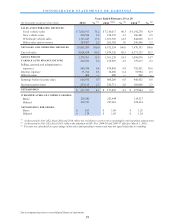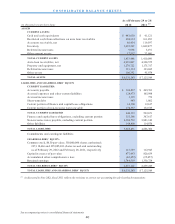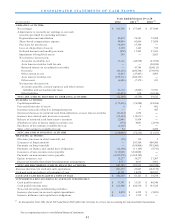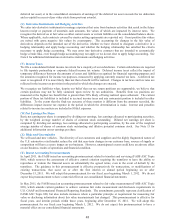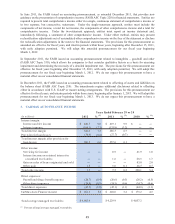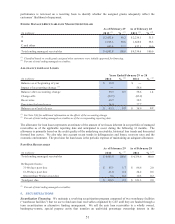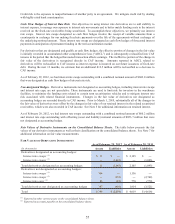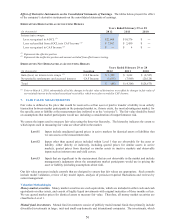CarMax 2012 Annual Report Download - page 54
Download and view the complete annual report
Please find page 54 of the 2012 CarMax annual report below. You can navigate through the pages in the report by either clicking on the pages listed below, or by using the keyword search tool below to find specific information within the annual report.48
deferred tax asset) or in the consolidated statements of earnings (if the deferred tax asset exceeds the tax deduction
and no capital in excess of par value exists from previous awards).
(U) Derivative Instruments and Hedging Activities
We enter into derivative instruments to manage exposures that arise from business activities that result in the future
known receipt or payment of uncertain cash amounts, the values of which are impacted by interest rates. We
recognize the derivatives at fair value as either current assets or current liabilities on the consolidated balance sheets.
Where applicable, such contracts covered by master netting agreements are reported net. Gross positive fair values
are netted with gross negative fair values by counterparty. The accounting for changes in the fair value of
derivatives depends on the intended use of the derivative, whether we have elected to designate a derivative in a
hedging relationship and apply hedge accounting and whether the hedging relationship has satisfied the criteria
necessary to apply hedge accounting. We may enter into derivative contracts that are intended to economically
hedge certain risks, even though hedge accounting may not apply or we do not elect to apply hedge accounting. See
Note 6 for additional information on derivative instruments and hedging activities.
(V) Income Taxes
We file a consolidated federal income tax return for a majority of our subsidiaries. Certain subsidiaries are required
to file separate partnership or corporate federal income tax returns. Deferred income taxes reflect the impact of
temporary differences between the amounts of assets and liabilities recognized for financial reporting purposes and
the amounts recognized for income tax purposes, measured by applying currently enacted tax laws. A deferred tax
asset is recognized if it is more likely than not that a benefit will be realized. Changes in tax laws and tax rates are
reflected in the income tax provision in the period in which the changes are enacted.
We recognize tax liabilities when, despite our belief that our tax return positions are supportable, we believe that
certain positions may not be fully sustained upon review by tax authorities. Benefits from tax positions are
measured at the highest tax benefit that is greater than 50% likely of being realized upon settlement. The current
portion of these tax liabilities is included in accrued income taxes and any noncurrent portion is included in other
liabilities. To the extent that the final tax outcome of these matters is different from the amounts recorded, the
differences impact income tax expense in the period in which the determination is made. Interest and penalties
related to income tax matters are included in SG&A expenses.
(W) Net Earnings Per Share
Basic net earnings per share is computed by dividing net earnings, less earnings allocated to participating securities,
by the weighted average number of shares of common stock outstanding. Diluted net earnings per share is
computed by dividing net earnings, less earnings allocated to participating securities, by the sum of the weighted
average number of shares of common stock outstanding and dilutive potential common stock. See Note 13 for
additional information on net earnings per share.
(X) Risks and Uncertainties
We sell used and new vehicles. The diversity of our customers and suppliers and the highly fragmented nature of
the U.S. automotive retail market reduce the risk that near-term changes in our customer base, sources of supply or
competition will have a severe impact on our business. However, unanticipated events could have an adverse effect
on our business, results of operations and financial condition.
(Y) Recent Accounting Pronouncements
In April 2011, the FASB issued an accounting pronouncement related to transfers and servicing (FASB ASC Topic
860), which removes the assessment of effective control criterion requiring the transferor to have the ability to
repurchase or redeem the financial assets on substantially the agreed terms, even in the event of default by the
transferee. The guidance in this pronouncement is effective prospectively for transactions, or modifications of
existing transactions, that occur on or after the first interim or annual period beginning on or after
December 15, 2011. We will adopt this pronouncement for our fiscal year beginning March 1, 2012. We do not
expect this pronouncement to have a material effect on our consolidated financial statements.
In May 2011, the FASB issued an accounting pronouncement related to fair value measurement (FASB ASC Topic
820), which amends current guidance to achieve common fair value measurement and disclosure requirements in
U.S. GAAP and International Financial Reporting Standards. The amendments generally represent clarification of
FASB ASC Topic 820, but also include instances where a particular principle or requirement for measuring fair
value or disclosing information about fair value measurements has changed. This pronouncement is effective for
fiscal years, and interim periods within those years, beginning after December 15, 2011. We will adopt this
pronouncement for our fiscal year beginning March 1, 2012. We do not expect this pronouncement to have a
material effect on our consolidated financial statements.



